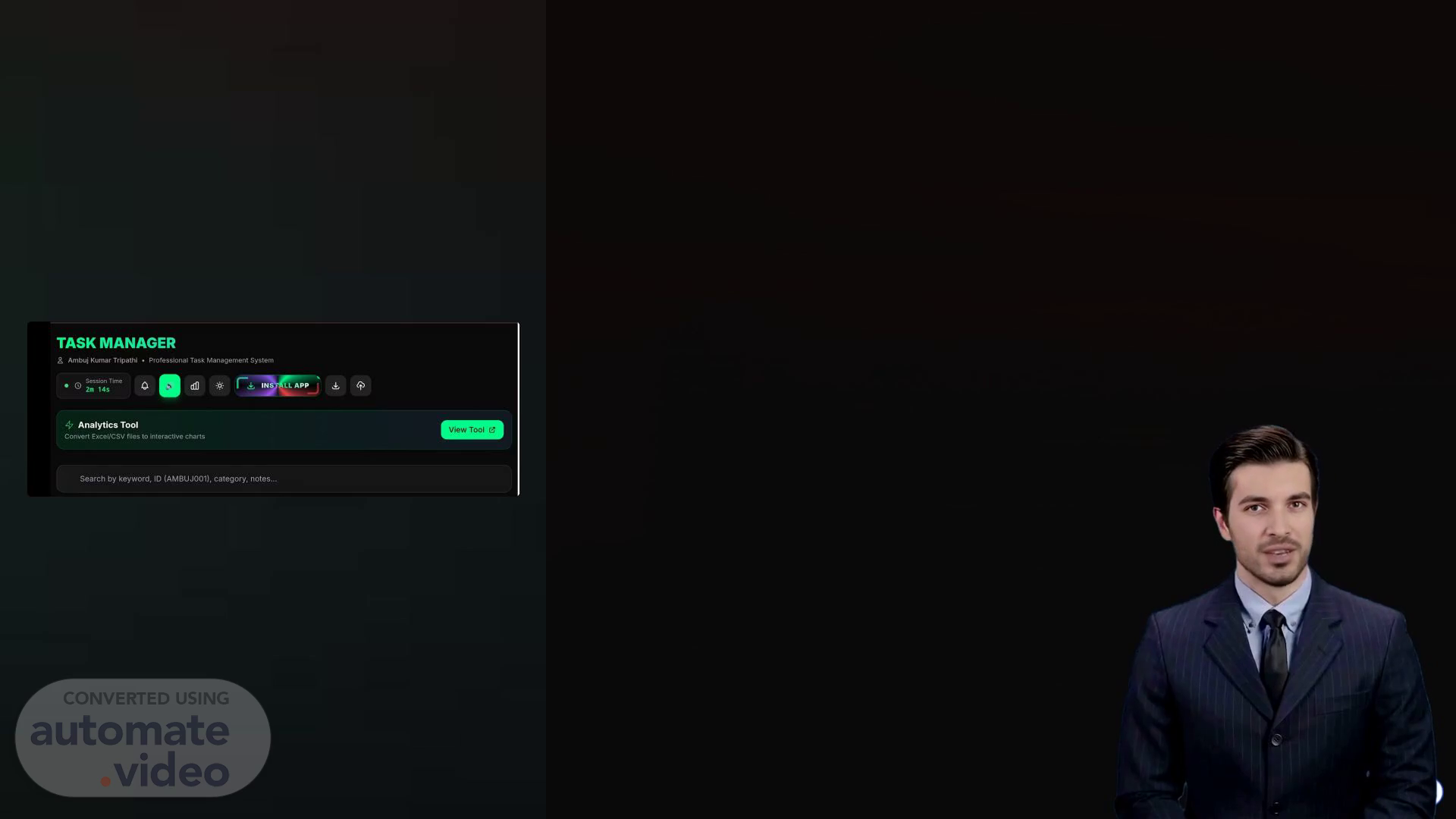Scene 1 (0s)
[Virtual Presenter] I am Ambuj Kumar Tripathi, a self-taught developer who has made a career change from telecommunications to artificial intelligence. The Task Manager PWA that I have created is a reflection of my technical background and my desire to develop innovative solutions using advanced technologies such as Artificial Intelligence. I designed this PWA using AI-assisted learning techniques, which enabled me to create a user-friendly interface and efficient workflow management system. The result is a powerful tool that streamlines task management and enhances productivity..
Scene 2 (41s)
[Audio] The task manager was built using HTML5, CSS3, JavaScript, and the Web Audio API. The development process involved several stages, including planning, design, implementation, testing, and deployment. The team worked closely together to ensure that all aspects of the task manager were thoroughly tested and validated. The use of Service Workers enabled offline functionality, which allowed users to access tasks even when they were not connected to the internet. Local storage was used to store data locally on the user's device, reducing the need for internet connectivity. The Web Audio API was utilized to create an immersive experience, allowing users to interact with the application in a more engaging way. The team incorporated features such as drag-and-drop functionality, keyboard shortcuts, and customizable workflows, making the task manager a comprehensive tool for managing tasks..
Scene 3 (1m 42s)
[Audio] Our application utilizes React hooks for state management, ensuring simplicity and performance. This approach allowed us to implement a robust and scalable architecture. The use of React hooks also enabled us to simplify the codebase, making it easier to maintain and update. To achieve offline-first functionality, we implemented service workers, which solved cache invalidation issues with version-based strategies. Service workers enable caching of resources, allowing users to access content even when they have no internet connection. By implementing service workers, we were able to provide a seamless experience for users who may not always have an active internet connection. Our audio integration utilizes both the Web Speech API and the Web Audio API, providing onboarding and action feedback. The Web Speech API allows developers to create speech-to-text applications, while the Web Audio API enables developers to create music and sound effects. By combining these two APIs, we were able to create a more comprehensive and engaging audio experience. In terms of data persistence, we created AMBUJ-prefixed IDs in JSON, allowing for easy task tracking and supporting over 500 unique entries. This approach ensured that tasks could be easily identified and retrieved, even in large datasets. We built a multi-field search with debouncing, resulting in a significant boost in retrieval speed by 30%. Deboncing ensures that searches are performed quickly and efficiently, reducing latency and improving overall system performance. Finally, we incorporated PWA features into our application, enabling seamless user experiences across various devices. PWA features allow developers to create responsive and interactive web pages that can be accessed from multiple devices, including desktops, laptops, and mobile phones. By incorporating PWA features, we were able to create a more intuitive and user-friendly interface..
Scene 4 (3m 54s)
[Audio] The website's performance was measured using various metrics including first contentful paint, time to interactive, and lighthouse score. These metrics provided insight into how well the website loaded and functioned on different devices. The goal was to achieve a lighthouse score of 100, which indicated optimal performance. The current score was 100, showing that the website met its performance goals..
Scene 5 (4m 20s)
[Audio] The project involved creating a task management system with multiple features such as adding, editing, deleting, and prioritizing tasks. The system was designed to be highly customizable and flexible, allowing users to personalize their workflow by selecting specific layouts and themes. Users could also access historical data and statistics about their productivity and time management. The system included a web-based interface that supported both desktop and mobile devices, making it accessible to a wide range of users. Additionally, the system incorporated various security measures to protect sensitive information, including encryption and secure authentication protocols. The development process involved several iterations and refinements, with each iteration building upon the previous one to ensure a high level of quality and reliability..
Scene 6 (5m 14s)
[Audio] The task manager PWA was built using React, JavaScript, HTML, and CSS. The core functionality of the task manager was implemented using React Hooks. The user interface was designed using CSS Grid Layout and CSS Flexbox. The data storage was handled by the IndexedDB API. The application's performance optimization techniques were applied using React Lazy Loading and Webpack Bundle Analyzer. The task manager's core features include adding new tasks, editing existing tasks, deleting tasks, and viewing task lists. These features are implemented using React Hooks and provide a seamless user experience. The task manager also includes a calendar view feature that allows users to view their tasks across different dates. This feature is implemented using a combination of React Hooks and the Google Calendar API..
